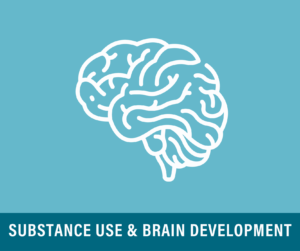Substance Use & Brain Development
The most powerful organ in the human body, as well as the most affected by substance use, is the brain.
Using drugs at any age can be dangerous, but before a person is 25 the brain is especially vulnerable and much more susceptible to substance use disorders, risky behavior, and irreversible damage due to substances.
In fact, 90% of people who have experienced addiction tried a substance before their 18th birthday.
Drug Facts
Nicotine is harmful to developing brains and its use during adolescence can disrupt the formation of brain circuits that control attention, learning, and susceptibility to addiction.
Nicotine exposure in its many forms can adversely affect adolescents:
- Affects key brain receptors, making young people more susceptible to nicotine addiction.
- Young people who have never smoked previously and began using e-cigarettes are more likely to smoke cigarettes in the future.
- Vaping is significantly associated with higher levels of ADHD symptoms, based on a 2019 study of college students.
- Studies have shown that nicotine can worsen anxiety symptoms and amplify feelings of depression.
- Nicotine use — whether through smoking or vaping — can increase stress levels.
Sources:
Long-term effects of Marijuana use:
- Lower IQ score in adulthood
- Learning and memory impairment
- Altered responses to pleasure and stress
- Increase risk for psychosis including schizophrenia
- Risk of developing a dependency on other drugs
Sources:
NIDA: What is Cannabis (Marijuana)
CDC: What You Need to Know about Cannabis use and Teens
American Addiction Centers: The Effects of Marijuana on the Teenage and Young Adult Brain
The earlier a person starts drinking alcohol at harmful levels, the greater the risk of changing the development of the brain. This can lead to problems with memory and learning and increases the risk of having alcohol-related problems later in life.
This can result in:
- Slurred Speech
- Confusion
- Poor Vision
- Poor Muscle Control and Judgment
- Slower Reactions
- Lack of Coordination
- Sleep Disruption
Sources:
NIAAA for Teens: Alcohol and Your Health
Mass General Brigham McLean: Just How Does Drinking Affect the Teenage Brain?
Prescription opioids activate receptors in the brain and decrease its pain signals. This receptor interaction is also associated with a release of dopamine into the brain. This can result in feelings of euphoria, elation, or pleasure. When dopamine is released, other areas of the brain react, creating a memory and associates it with pleasure.
Some potential short-term, neurological effects of opioids include:
- Mood changes.
- Depression.
- Drowsiness.
- Impaired memory, judgment, and attention.
Over the long term, prescription drug abuse will affect the brain in the following ways:
- Tolerance: Higher and more doses will need to be taken to achieve the same effects.
- Drug dependence: Withdrawal symptoms such as depression, insomnia, anxiety, restlessness, and irritability can be unpleasant. The individual may decide to continue taking the drugs to avoid these withdrawal symptoms in an attempt to appear to function ‘normally.’
Sources:
Peaks Recovery Centers: How Do Prescription Drugs Affect the Brain
Alcohol & the Teenage Brain
Cannabis & the Teenage Brain
Protective & Risk Factors
What are protective vs. risk factors? Risk factors increase the likelihood that a youth will be susceptible to use substances, while protective factors decrease this likelihood. While it’s impossible to eliminate all risk factors for every youth, prevention seeks to lower the amount of risk factors and increase the amount of protective factors. Many of these factors are connected and are not limited to just one area of a youth’s life. Take a look at this diagram to understand more about what some risk and protective factors are.

Learn More
Additional Resources
Below is a list of additional resources for those looking to learn more about substance use and prevention. Please see our GET HELP page for cessation, treatment, and recovery resources.
iLearn Wellness – The goal of iLearn Wellness group is to create a supportive environment through evidence-based therapies and academic excellence to encourage resiliency and healing and a return to family, community, and school.
Learn to Cope – This nonprofit support network offers education, resources, peer support, and hope for parents and family members coping with a loved one addicted to opiates or other drugs.
Maryland Collaborative– The Maryland Collaborative seeks to reduce excessive college drinking and resulting social and economic costs by raising awareness of college student drinking as a statewide public health problem and by helping college communities implement effective policies and practices to reduce the problem.
Notice. Talk. Act. – Supporting parents or guardians in promoting the wellbeing of children and family members during and beyond the
COVID-19 pandemic.
Operation Parent – Operation Parent is a national nonprofit that exists to empower parents and caregivers to fully engage in ongoing conversations with their K-12 children about technology, substance use, and mental health issues for purposes of prevention.
Partnership to End Addiction – Catching it early: Not sure how to prevent drug or alcohol use? Or what to do if you suspect or have discovered substance use? Read about the science- and research-backed information to help you help your child.
Playbook for Parents of Pre-Teens – Protecting your pre-teen’s well-being and heading off problems.
Playbook for Parents of Teens – Protecting your teenager’s well-being and handling challenges they may face.
Rethinking Drinking – Designed for U.S. adults who drink alcohol. It provides evidence-based information about alcohol and health along with tips, tools, and resources for those who want to cut down on or quit drinking.
SAMHSA Talk. They Hear You. – SAMHSA’s national substance use prevention campaign helps parents and caregivers, educators, and community members get informed, be prepared, and take action.
Stanford REACH Lab – The REACH lab’s research focuses on reducing risky behaviors and substance use including e-cigarettes, cigarettes, alcohol, and marijuana.
Talking to Kids about Alcohol and other Drugs: 5 Conversation Goals
Why Prevention?
When it comes to substance use, there are many ways the community can work to help solve the problem. At EWOH, our primary focus is on youth substance use prevention. But why prevention?
Prevention seeks to assess the root of the problem and formulate strategies that will help reduce substance use now, and in the future. By working to change community norms, systems, and polices, we can help create a safer, healthier Easton.
Moving Prevention Upstream – click here to see how traveling upstream creates the greatest change in communities.
Easton Data
Easton Surveys
Through collaboration with Easton Public Schools and Old Colony YMCA, Easton Wings of Hope coordinates data collection on core measures to assess health disparities. The Youth Health Survey is conducted every two years for grades 7-12, and a Parent/Caregiver Survey is conducted on the alternate year for parents of Easton students in grades K-12. The core measures assessed include 30-day use (current use), perception of risk, perception of peer disapproval, and perception of parental disapproval.
See reports below.
Making Meaning of the Data
The EWOH staff and Steering Committee work with community partners to examine the data collected on an annual basis to compare to past years and state and national data to make meaning of the results.






